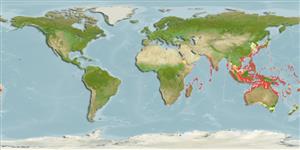分類 / Names
共通名の | 類義語 | Catalog of Fishes(部類, 種) | ITIS | CoL | WoRMS | Cloffa
Environment: milieu / climate zone / depth range / distribution range
生態学
海 関連する礁; 深さの範囲 1 - 55 m (Ref. 9710). Subtropical
Indo-West Pacific: tropical and subtropical waters, South Africa eastward through Indonesia; northward to southern Japan; southward to the east coast of Australia (Ref. 33352). Southeast Atlantic: south coast of South Africa.
サイズ / 重さ / 年齢
Maturity: Lm ? range ? - ? cm
Max length : 19.0 cm TL オス/雌雄の選別がない; (Ref. 9710)
背面の脊椎 (合計) : 2; 背鰭 (合計) : 43 - 50; 肛門の骨: 0; 臀鰭: 41 - 46. Pale brown to grey in color; two brown stripes on body; adults with yellow spots on head and body; soft dorsal and anal fins yellowish; caudal fin dark brown (Ref. 4421).
Inhabit coastal reefs and enter estuaries. Often in silty habitat and usually on slopes with low rubble reef and rich invertebrate growth, ranging to moderate depths (Ref. 48637). Found on weedy and sandy areas of lagoon and seaward reefs (Ref. 9710). Often found in pairs (Ref. 9710). Sometimes solitary or in groups (Ref. 90102). Juveniles hide or shelter near seawhips or seapens (Ref. 48637).
Life cycle and mating behavior
成熟 | 繁殖 | 放精 | 卵 | 生産力 | 幼生
Masuda, H., K. Amaoka, C. Araga, T. Uyeno and T. Yoshino, 1984. The fishes of the Japanese Archipelago. Vol. 1. Tokai University Press, Tokyo, Japan. 437 p. (text). (Ref. 559)
IUCNのレッドリストの状況は (Ref. 130435: Version 2024-1)
Human uses
用具
特記事項
XMLをダウンロードして下さい
インターネットの情報源
Estimates based on models
Preferred temperature (Ref.
123201): 22.4 - 29, mean 27.7 °C (based on 974 cells).
Phylogenetic diversity index (Ref.
82804): PD
50 = 1.0000 [Uniqueness, from 0.5 = low to 2.0 = high].
Bayesian length-weight: a=0.00955 (0.00501 - 0.01821), b=3.07 (2.90 - 3.24), in cm total length, based on LWR estimates for this species & (Sub)family-body (Ref.
93245).
栄養段階 (Ref.
69278): 3.1 ±0.0 se; based on diet studies.
回復力 (Ref.
120179): 高い, 15か月以下の倍増期間の最小個体群 (Preliminary K or Fecundity.).
Fishing Vulnerability (Ref.
59153): Low vulnerability (10 of 100).
Nutrients (Ref.
124155): Calcium = 38.9 [14.5, 124.6] mg/100g; Iron = 0.757 [0.328, 1.742] mg/100g; Protein = 19.2 [17.0, 21.4] %; Omega3 = 0.227 [0.099, 0.466] g/100g; Selenium = 13.9 [6.2, 32.8] μg/100g; VitaminA = 62.3 [20.9, 191.6] μg/100g; Zinc = 1.04 [0.65, 1.73] mg/100g (wet weight);
